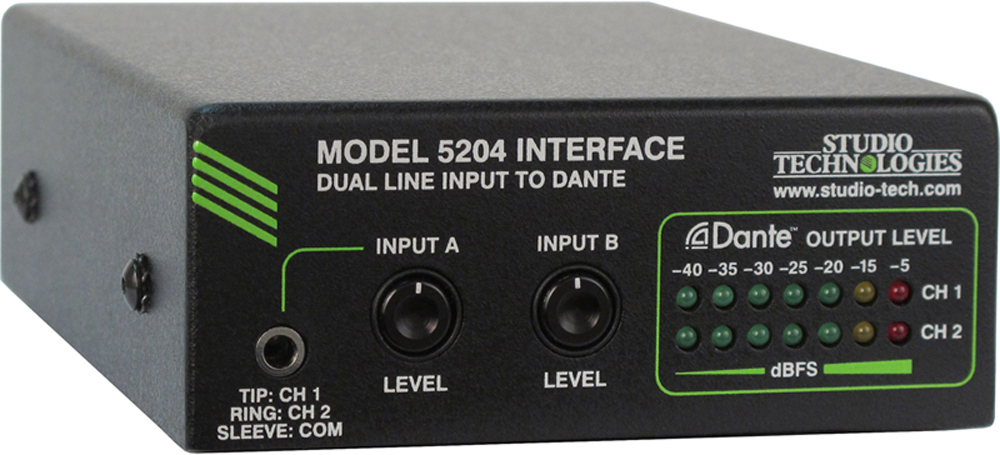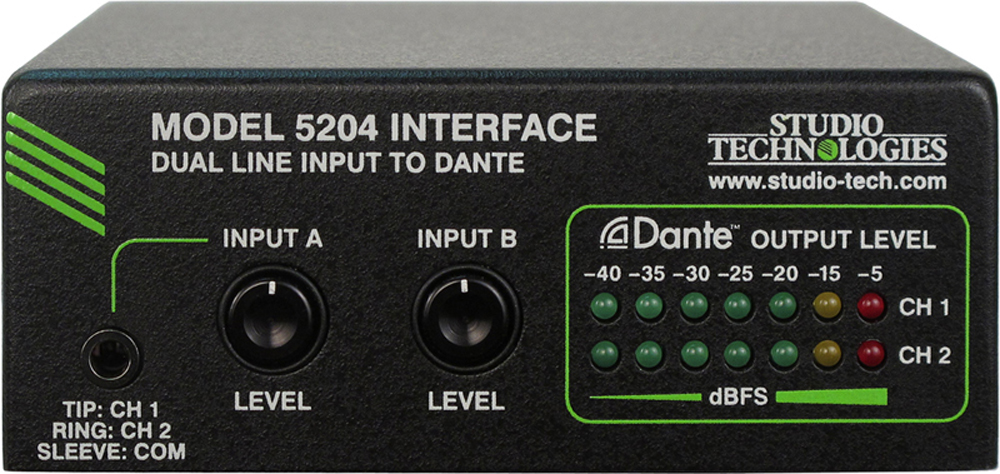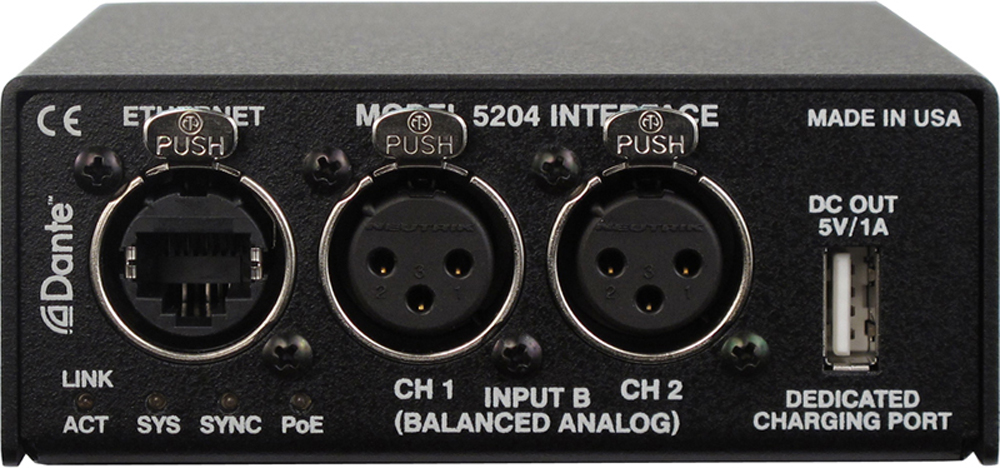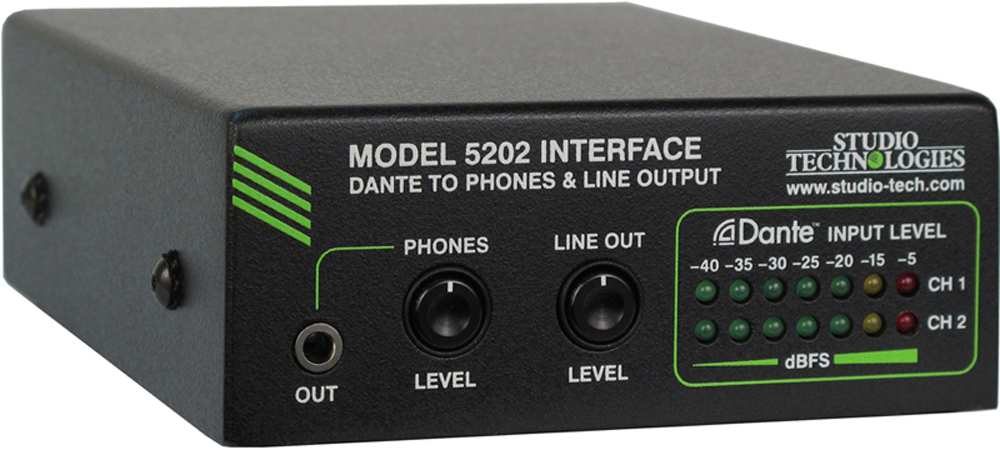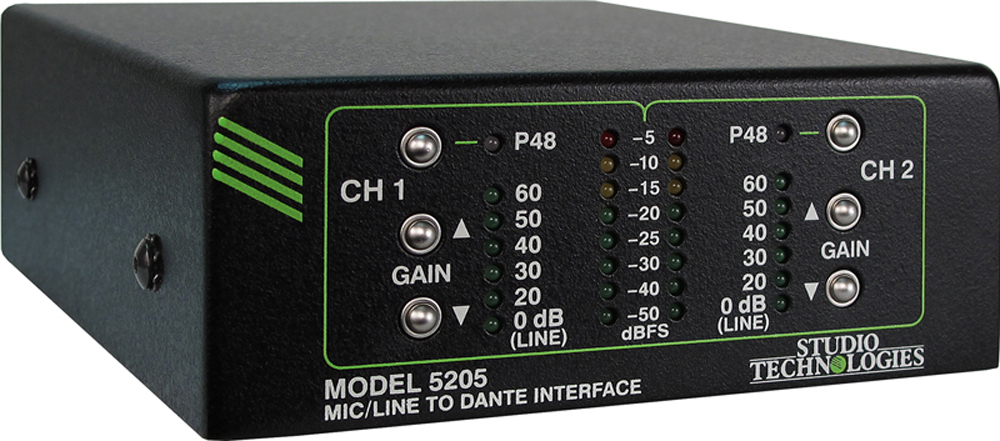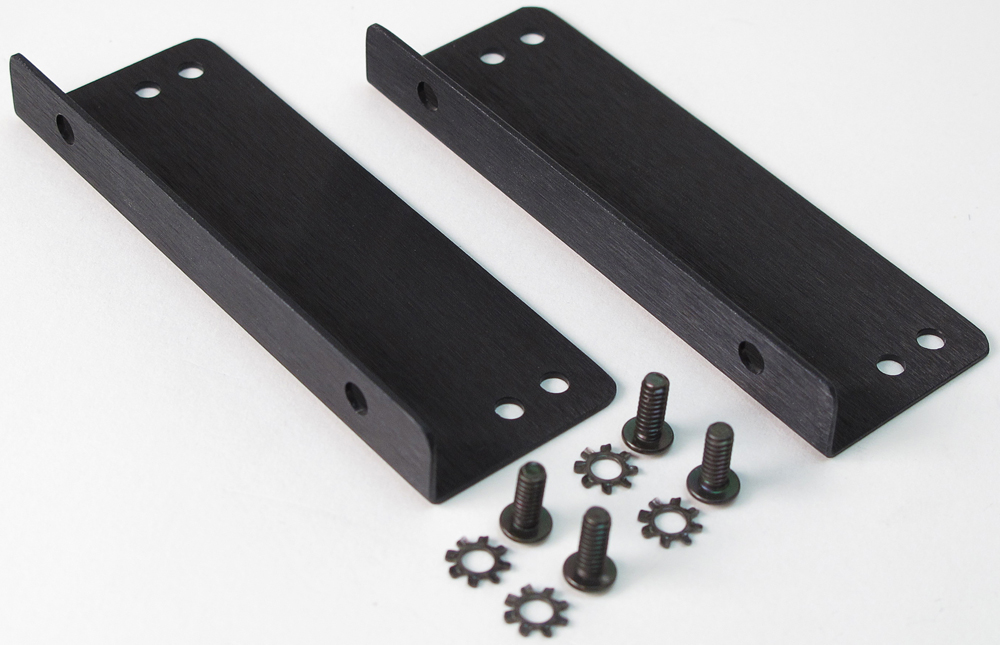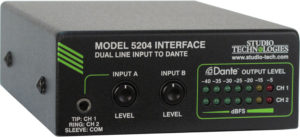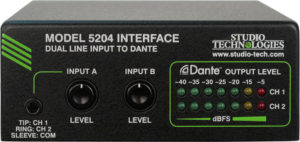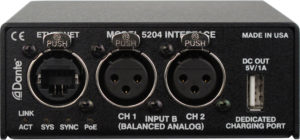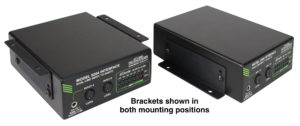The Model 5204 Dual Line Input to Dante Interface is a general-purpose audio device that supports applications utilizing the Dante® audio-over-Ethernet media networking technology. Two 2-channel ("stereo") analog line-level audio signals can be connected to the Model 5204 and then converted to two channels on an associated Dante connection.
Analog audio signals connect to line input A by way of a 3-conductor ("stereo") 3.5 mm jack. This allows the direct interfacing of signals from a variety of sources such as personal audio and multimedia players, smartphones, and personal computers. These signals typically have an average (nominal) signal level in the range of –20 to –10 dBu. Line input B supports connection of balanced analog audio signals using two XLR connectors. Average signal levels for these types of signals are typically in the range of 0 to +4 dBu. Each input has an associated dual-channel rotary level control to optimize its audio performance. Following the level "pots" the signals from inputs A and B are summed (combined or mixed together) to create one 2-channel signal. (The channel 1 signals of line inputs A and B are summed to create output channel 1; channel 2 signals of line inputs A and B are summed to create output channel 2.) The two channels are then output by way of the Dante interface. Multi-step LED meters provide confirmation of the level of the two output audio channels.
The audio quality of the Model 5204 is excellent, with low distortion and noise and high headroom. Careful circuit design and excellent components ensure long, reliable operation. A wide range of applications can be supported, including TV, radio, and streaming broadcast events, corporate and government AV installations, and Dante system testing.
For user convenience a dedicated charging port (DCP) is provided on a standard USB type A connector. This allows powering and charging of associated devices, such as personal audio players and tablets. The compact, lightweight design allows the Model 5204 to be used in portable or desktop situations or deployed as a permanent solution in fixed applications. Standard connectors ensure fast, reliable deployment. The unit requires only an Ethernet connection to supply both the data interface as well as Power-over-Ethernet (PoE) power. The Model 5204's audio, data, and dedicated charging port use power provided by the PoE connection.
Applications
The Model 5204 is perfect for use in conjunction with a variety of fixed and portable audio equipment that offer analog output signals. An obvious application is with legacy equipment that only offers analog outputs. A few simple connections are all that's required to covert those signals into the world of audio-over-Ethernet. When deploying, maintaining, or modifying Dante networks the unit can be a useful test tool, offering a simple, high-quality means of creating a 2-channel signal source. For permanent applications there's no reason why a Model 5204 can't reside within an equipment rack or be mounted, using optional brackets, underneath a table or on-air studio set. In a conference room setting the unit can be permanently connected to a PoE-enabled Ethernet port, ready to accept a signal source from various user-provided devices.
Line Input A
Using a 3-conductor ("stereo") 3.5 mm jack, it's a simple matter to connect unbalanced sources to the Model 5204's line input A. These signals would typically be provided by personal computers, smartphones, or personal audio devices which have average (nominal) levels in the range of –20 to –10 dBu. One rotary control is used to adjust the input level, making it a simple task to optimize the conversion of the input analog audio source to the Dante output. The level knob is a push-in/push-out type which helps prevent inadvertent adjustment.
Line Input B
The Model 5204's line input B is designed for use with professional line-level analog audio signals. The 2-channel input is electronically balanced, capacitor-coupled, and uses two standard 3-pin female XLR connectors. A single rotary level control allows the input sensitivity of both channels to be adjusted. Using the push-in/push-out knob it's a simple matter to adjust the input circuitry to match average (nominal) signal levels which would typically be in the range of 0 to +4 dBu. And with a maximum input level of +24 dBu there will always be sufficient headroom for "pro" audio performance. Protection components in the input circuitry help ensure reliability in tough field applications.
Summing (Mixing) of the Input Signals
The two channels associated with line input A and the two channels associated with line input B are mixed (summed), sent to analog-to-digital conversion circuitry, and then transmitted over the Dante network. The two signals associated with the channel 1 (or "left") inputs are combined and sent out Dante channel 1. The two signals associated with the channel 2 (or "right") inputs are combined and sent out Dante channel 2. (There is no provision for creating a monaural signal which is typically not an issue as other connected Dante-enabled equipment can usually perform such tasks.)
Metering
Two 7-step LED meters provide a real-time level indication of the two audio output channels. Scaled in dBFS (decibels referenced to full scale digital) the meters offer a direct view of the signal levels as they are transported in the digital domain via Dante. Optimal audio performance requires transporting signals at their proper levels — without an accurate indication this can be difficult to achieve.
Ethernet Data and PoE
The Model 5204 connects to a data network using a standard 100 Mb/s twisted-pair Ethernet interface. The physical interconnection is made by way of a Neutrik® etherCON RJ45 connector. While compatible with standard RJ45 plugs, etherCON allows a ruggedized and locking interconnection for harsh or high-reliability environments. An LED displays the status of the network connection.
The Model 5204's operating power is provided by way of the Ethernet interface using the Power-over-Ethernet (PoE) standard. This allows fast and efficient interconnection with the associated data network. To support PoE power management, the Model 5204's PoE interface reports to the power sourcing equipment (PSE) that it's a class 3 (mid power) device. An LED is provided to indicate when power is being supplied to the Model 5204. Note that no provision has been made to allow an external power source to be connected. However, if the associated Ethernet switch does not provide PoE capability a commonly-available mid-span PoE power injector can be utilized.
Dedicated Charging Port (DCP)
A unique resource is the Model 5204's dedicated charging port. Using a standard USB type A receptacle, the port has a 5 volt output with a maximum current of approximately 1 amp. This nominally 5 watt output should be sufficient to rapidly charge a personal audio player, smartphone, or tablet device. An auto-detect feature supports divider mode, short mode, and 1.2 V/1.2 V charging modes. Besides charging, the port can allow a connected device to continuously send audio to the associated Dante network without requiring an external power source. Note that in this situation interfacing a device with the Model 5204 requires separate cables, one for the analog audio source and one for powering/charging.
One note of interest: the dedicated charging port derives its power from the Ethernet with Power-over-Ethernet (PoE) connection. While the Model 5204's audio and data circuitry takes very little energy, the dedicated charging port can source up to approximately 5 watts. As such, the Model 5204's Ethernet interface will identify itself to upstream power-sourcing-equipment (PSE), typically an Ethernet switch with integrated PoE, as a PoE class 3 powered device (PD).
Dante Audio-over-Ethernet
Audio data is sent from the Model 5204 using the Dante audio-over-Ethernet media networking technology. As a Dante-compliant device, the Model 5204's two audio channels can be assigned to other devices using the Dante Controller software application. Bit depths of up to 24 and sample rates of 44.1, 48, 88.2, and 96 kHz are supported. Two bi-color LEDs provide an indication of the Dante connection status.
The Model 5204 is compliant with the AES67 interoperability standard. In addition, the unit is compatible with the Dante Domain Manager™ (DDM) software application.
The Model 5204 uses Audinate's Ultimo™ integrated circuit for implementing Dante. The integrated circuit's firmware can be updated via the Ethernet connection, helping to ensure that its capabilities remain up to date.

